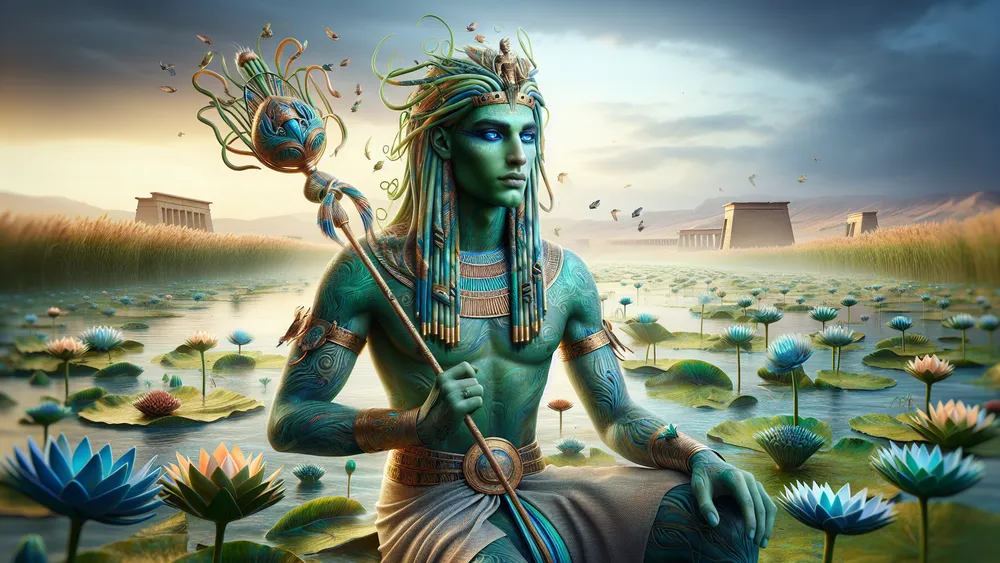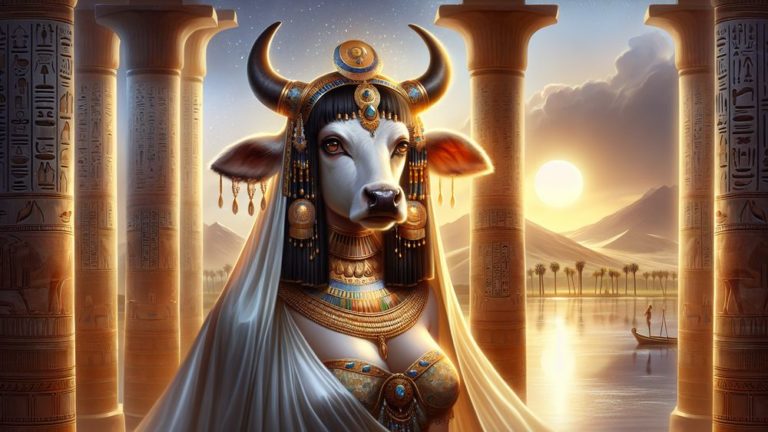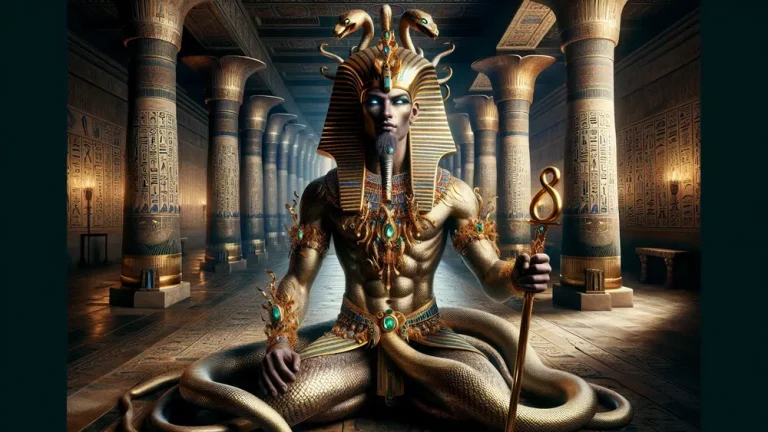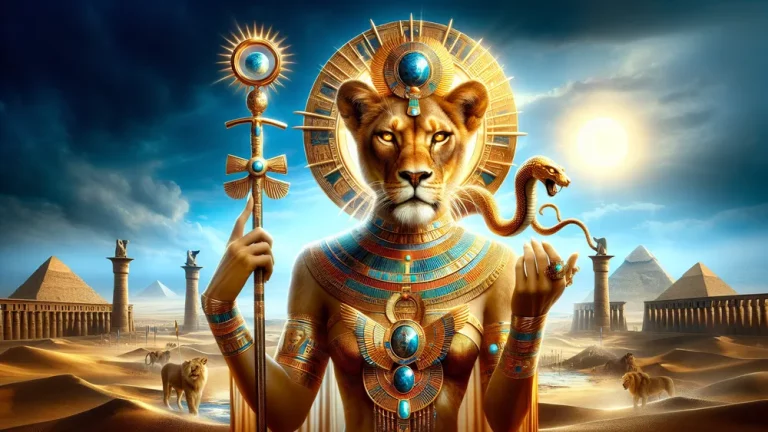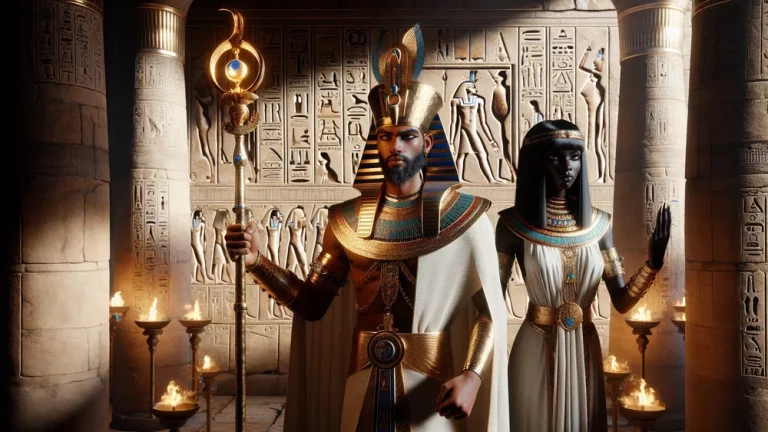Wadj-Wer: Egyptian God Of Fertility And The Sea
Greetings. This text is about Wadj-Wer, who is the god connected to making things grow and the sea in Egypt. For those not familiar with Egyptian stories, Wadj-Wer can be compared to how water is known to help and give life nowadays.
Key Points:
- Wadj-Wer is an Egyptian god of fertility and the sea.
- He was known for making crops grow and providing abundance.
- Wadj-Wer’s origins date back to the Old Kingdom period in Egypt.
- Depicted as a man with water-related features like a water pot.
- Worship practices included water offering rituals and prayers for abundance.
- Wadj-Wer was vital for farming growth and life support through water.
- His influence extended outside Egypt, impacting neighboring cultures.
Life needs water, and Wadj-Wer was thought of as a main god making things grow and providing plenty for the Egyptians long ago. This text will look into where Wadj-Wer came from, main facts about him, his looks and what he stands for, and the big parts he played in stories from Egypt.
We will also see how Wadj-Wer’s reach went past Egypt and how his worship was part of daily life and culture. By finishing, you will know much about this interesting god and how he is part of the rich stories from Egypt. Now, let’s get started and find out more about Wadj-Wer’s background.
Wadj-Wer: Overview and Key Facts
| Key Point | Description |
|---|---|
| Name | Wadj-Wer |
| Role | God of making things grow and the sea |
| Origins | From old Egyptian stories, mostly during the Old Kingdom time |
| Depictions | Shown often as a man with a pot for water or with water-related features |
| Symbols | Water, symbols for making things grow, water plants |
| Primary Sources | Pyramid Texts, Coffin Texts, and different temple writings |
| Cultural Significance | Vital for farming growth and life support through water |
| Worship Practices | Water offering rituals, prayers for making things plentiful |
| Influence Beyond Egypt | Some mix with nearby cultures, mainly worshipped inside Egypt |
| Modern References | Sometimes seen in books and media about Egyptian myths |
Getting to Know Wadj-Wer
To truly understand Wadj-Wer’s importance, let’s look into where he came from, what he was like, and the parts he played in old Egyptian myths.
Where Wadj-Wer Came From
Wadj-Wer, whose name means “Great Green,” is a god strongly connected to the history and stories of old Egypt. He first became known in the Old Kingdom time, seen as a god over making things grow and the sea, and showing the life-giving power of water. Water was life to a land along the Nile; it meant growth and survival.
Wadj-Wer’s link with these crucial parts made him important in the Egyptian group of gods. His story beginnings mix with nature, showing the respect Egyptians had for the powers keeping their farming society alive.

Texts and items from old Egypt show Wadj-Wer often as a man holding a water pot or with water-related looks, meaning he ruled over water and making things grow. Seen in many main sources, including Pyramid Texts and Coffin Texts, some of the world’s oldest religious writings, his images are. These texts talk about Wadj-Wer and emphasize his role in rituals for growth and plenty. Some key texts mentioning Wadj-Wer are:
- Pyramid Texts: Old religious words written in Old Kingdom pyramids.
- Coffin Texts: Spells for the dead written on coffins in Middle Kingdom times.
- Temple Inscriptions: Various writings found in temples for different gods.
These texts give valuable views into Wadj-Wer’s role and worship, showing his importance in old Egypt’s religion and culture.
Wadj-Wer, the god of water and growth in ancient Egypt, played a crucial role in the religion and culture of that time, as evidenced by his representations in various ancient texts and artifacts.
What Wadj-Wer Looks Like and Stands For
In old Egyptian art and writing, Wadj-Wer is usually shown with unique physical and symbolic traits, showing his link to water and making things grow. Normally, seen as a man carrying a water pot, he provides life-giving water. Sometimes having water features, like a body covered with water plants or fish, shows his control over the sea and rivers.
These pictures are not just drawn choices but really mean much, showing water’s big part in keeping life and helping things grow in old Egypt.
Wadj-Wer’s look and symbols in old Egyptian times mean a lot. Water was very valuable, needed for farming, daily life, and religious events. Water was life to the Egyptians. With water symbols, Wadj-Wer meant the start of all life and plenty. His symbols, like the water pot and water plants, serve as strong reminders of water’s need in a dry place. Important traits tied to Wadj-Wer are:
- Water Pot: Means giving important water.
- Water Plants: Stands for growing and nature.
- Fish: Shows his tie to seas and rivers.
These traits made Wadj-Wer a key god in the Egyptian group of gods, known for bringing growth and plenty. His pictures always reminded people of how important water was for living and doing well in old Egyptian life.
Wadj-Wer’s Job in Egyptian Myths
We now have a clear view of Wadj-Wer’s beginnings and traits. Let us look at the parts he played in old Egyptian tales and stories.
Wadj-Wer and Fertility
Wadj-Wer’s job in making things grow and plentiful in old Egyptian stories was very important. Being a god linked with water, he was closely tied to the land’s fertility, depending a lot on the yearly Nile River floods. These floods dropped nutrient-filled silt onto the fields, making them good for growing lots of food. Wadj-Wer was seen as a key force in keeping the Egyptian people thriving.
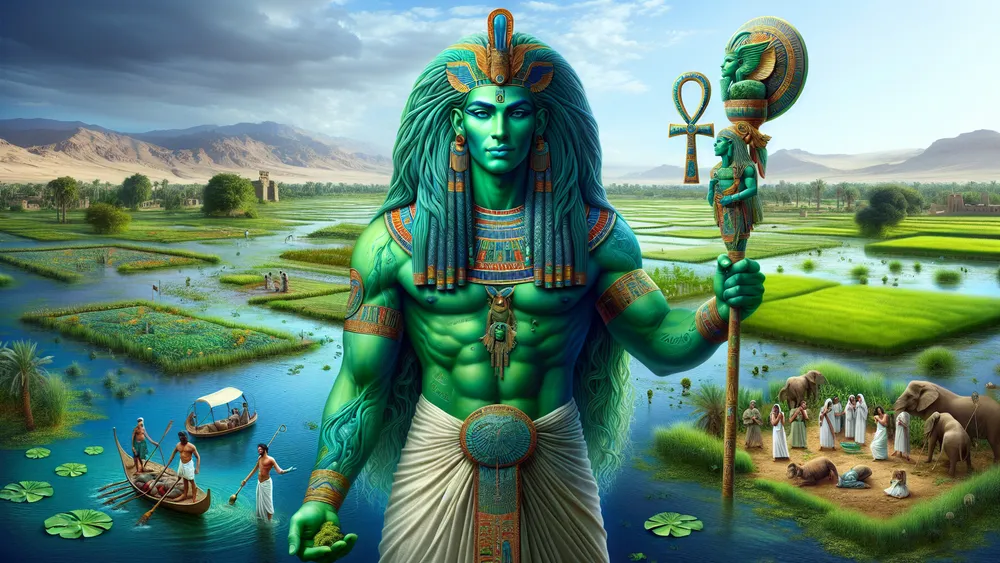
He was more than just about farming; he also stood for human fertility, showing nature’s creative powers.
Many old stories and myths show Wadj-Wer’s link to fertility. People often called on him in prayers and rituals for a good harvest or healthy children. These acts were a part of daily Egyptian life, relying on gods like Wadj-Wer for their well-being. Things done for Wadj-Wer to help grow things and people included:
- Offering Water: Meaning Wadj-Wer’s life-giving waters.
- Farm Produce: Giving the first harvest goods to keep land fertile.
- Priestly Acts: Done to ask for Wadj-Wer’s help for the land and people.
These rituals and old tales show how deeply Wadj-Wer was connected to fertility, marking his key place in the religious and everyday life of old Egypt.
Wadj-Wer as a Water God
Wadj-Wer was a vital god of the sea and waterways in old Egyptian stories. His control of water covered the sea, rivers, and other water places, making him a key god in a culture that relied so much on the Nile River. The Nile was the life’s blood of Egypt, giving needed things for farming, moving around, and daily living.
As a god showing these waters, Wadj-Wer was honored for his power to control and give the life-giving parts of water. He reminded people of the natural forces that kept the Egyptian lifestyle going.
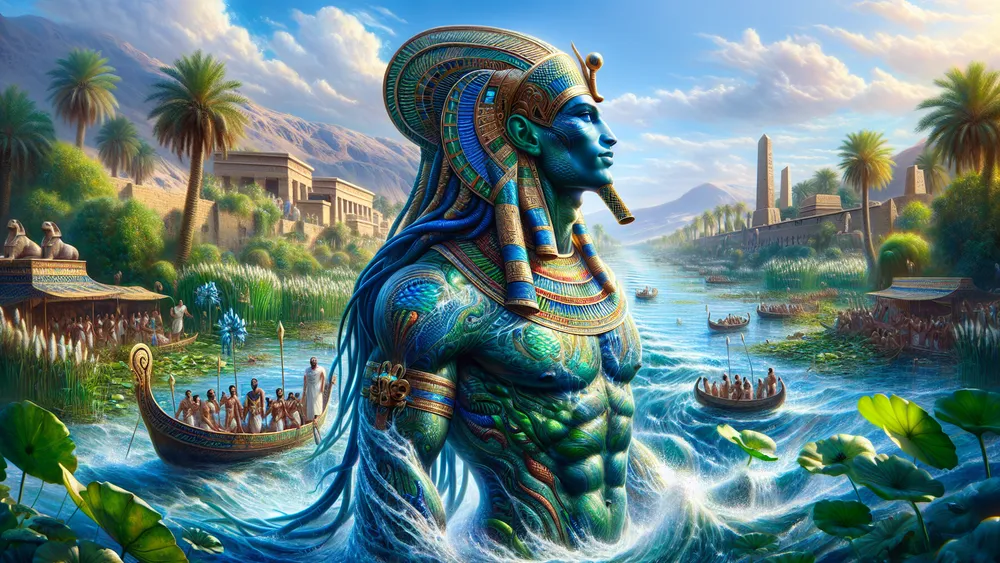
Water meant a lot in old Egyptian stories, being the source of life, new beginnings, and cleaning. Water was central in creation tales. The first waters of Nun were thought to be where everything started. Wadj-Wer, as a water god, fit right into this idea, showing the important parts of water needed for the Egyptians. It helps to look at Wadj-Wer’s role next to other sea gods from old cultures. Here’s a table to compare:
| Deity | Culture | Domain | Key Attributes |
|---|---|---|---|
| Wadj-Wer | Egyptian | Sea and Waterways | Water pot, aquatic plants, fish |
| Poseidon | Greek | Sea, Earthquakes | Trident, horse, dolphin |
| Neptune | Roman | Sea, Freshwater | Trident, horse, sea chariot |
| Tlaloc | Aztec | Rain, Water | Goggle eyes, fangs, water jar |
This table shows what makes Wadj-Wer and other sea gods unique and similar, explaining how different cultures turned water into powerful and life-giving gods.
The Importance of Water Gods in Ancient Egypt
Water gods were very important in old Egyptian beliefs. They stood for life, renewal, and cleanliness. Egyptians saw water as a godly thing needed for living, growing food, and cleaning souls. Wadj-Wer was a big water god who was part of this group of gods that showed the life-giving parts of water.
Wadj-Wer had a special link to the Nile River, which was Egypt’s main source of life. He was seen not just as a symbol; he was thought to control the land’s fertility and help the people prosper. This made Wadj-Wer very important in both the religious and cultural world of old Egypt, just like how other places had their own water gods that were crucial for nature and life.
Water gods, like Wadj-Wer in ancient Egypt, symbolized life and fertility, playing a vital role in religious and cultural beliefs.
Wadj-Wer’s Reach Beyond Egypt
First, we looked at Wadj-Wer’s role in old Egypt. Now, consider how his power and importance spread outside this ancient land’s limits.
Wadj-Wer in Other Cultures
Wadj-Wer’s reach went beyond old Egypt’s borders. Neighboring cultures took in and changed deities through cultural sharing. For example, in places where Egyptian and Greek cultures met, like during the Hellenistic times, Wadj-Wer’s traits as a water god might have mixed with those of Greek gods such as Poseidon.
This mix-up of gods happened often in old religions, where traits of one god got into the stories of another culture. This way of blending gods meant Wadj-Wer wasn’t seen only as an Egyptian god but as a common symbol of water and fertility, important to basic human needs for water.
This sharing between cultures shows how old stories about gods were flexible and how gods like Wadj-Wer could go beyond their original cultures to become important in new places.
Wadj-Wer’s Effect on Egyptian Life and Culture
Honoring Wadj-Wer had a big impact on daily life and how people behaved in ancient Egypt. Linked with the Nile and growing crops, Wadj-Wer was key to farming and feeding everyone. They did rituals and gave offerings to Wadj-Wer often, especially when the Nile flooded each year, which was crucial for making the soil good again and getting big harvests.
These acts showed how important water and crops were, shaping norms around respecting natural resources. Like modern places might have water-saving campaigns, ancient Egyptians had religious acts to honor Wadj-Wer, showing they deeply understood the link between nature and living. Evidence of Wadj-Wer’s worship can be found in different temples and items. Temples for water gods, like Wadj-Wer, were usually near important water spots, like the Nile or holy lakes.
These places were centers for worship and community gatherings, where rituals were done to get the god’s blessings. Inscriptions and pictures of Wadj-Wer in these temples give clues about the religious acts and the high respect he got.
For example, temple carvings often show Wadj-Wer with symbols of water and crops, pointing to his role in making sure the land thrived. This archaeological evidence doesn’t just show the physical places for his worship but also highlights how crucial Wadj-Wer was in ancient Egyptian life and religion.
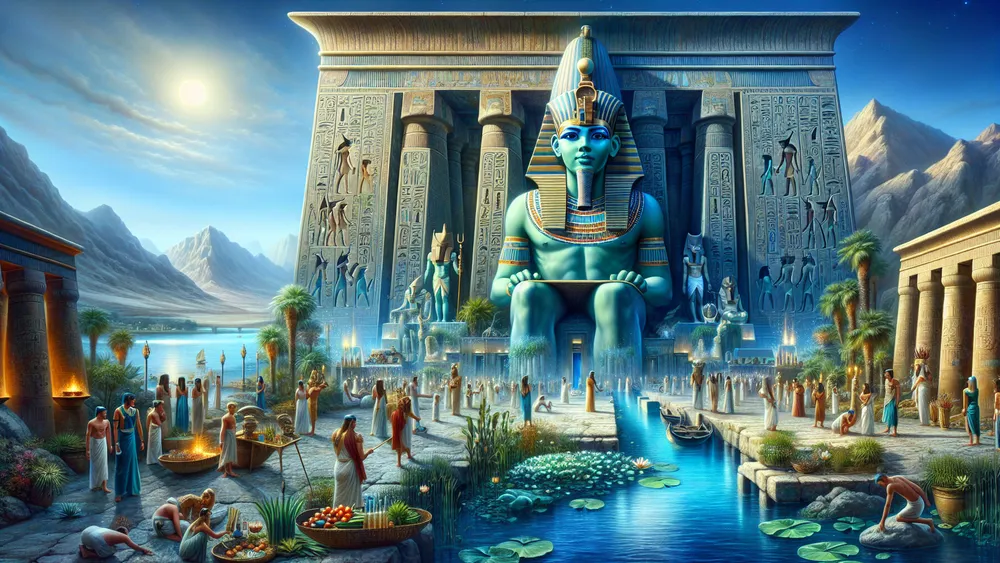
Wadj-Wer Today
These days, the stories of Wadj-Wer have stayed around and changed, showing that people are still curious about old Egyptian gods. Direct worship of Wadj-Wer is not common now, but his story lives on through cultural mentions and the new interest in old Egyptian religion.
For example, modern neopagan groups and others sometimes add Wadj-Wer to their practices, trying to bring back worship of old gods in today’s world. Plus, Wadj-Wer shows up in popular things like books, TV shows, and video games, where his story and features are redone for new viewers.
This new interest is like how old famous people are often found again and celebrated today, showing the lasting interest in old stories and their importance to today’s culture.
FAQs
1. Who Was Wadj-Wer In The Egyptian Pantheon?
Wadj-Wer in the Egyptian pantheon was a deity associated with fertility and the sea, often depicted as a personification of the Nile Delta’s abundant waters.
2. How Did Wadj-Wer Compare To Other Water Deities In Ancient Cultures?
Wadj-Wer compared to other water deities in ancient cultures by embodying both fertility and the life-giving aspects of water, similar to deities like Poseidon in Greek mythology and Enki in Mesopotamian mythology.
3. What Symbols Are Associated With Wadj-Wer?
Symbols associated with Wadj-Wer include the blue-green skin and aquatic motifs, representing his dominion over water and fertility.
4. How Is Wadj-Wer Relevant To The Understanding Of Ancient Egyptian Society?
Wadj-Wer is relevant to the understanding of ancient Egyptian society because his worship highlights the importance of fertility and water in their daily life and religious practices.

